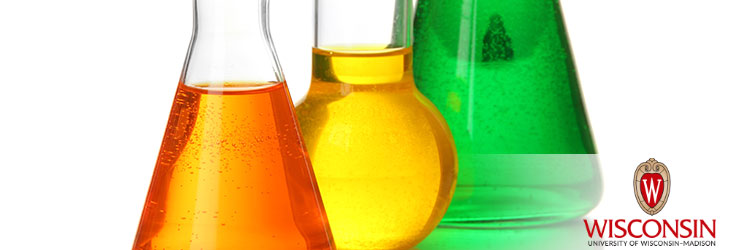Materials & Chemicals

Concentrated C5 and C6 Sugars from Biomass
WARF: P140075US01
Inventors: James Dumesic, David Martin Alonso, Jeremy Luterbacher
The Wisconsin Alumni Research Foundation (WARF) is seeking commercial partners interested in developing a milder biomass pretreatment method that yields high concentrations of C5 and C6 carbohydrates and their derivatives.
Overview
Widespread production of sustainable fuels and chemicals will require cost-effective methods for breaking down biomass into its constituent sugars. Attaining high yields of concentrated C5 and C6 carbohydrates (e.g., xylose and glucose) is particularly challenging. Many processes have been tested but all have drawbacks such as very high temperatures or expensive acids and enzymes.
Clearly needed is a process for extracting both types of sugar under more practical reaction conditions.
Clearly needed is a process for extracting both types of sugar under more practical reaction conditions.
The Invention
UW–Madison researchers have developed a process for producing C5 and C6 sugars from biomass at high yields (70 to 90 percent) in a solvent mixture of water, dilute acid and GVL (gamma-valerolactone). GVL is attractive because it is effective and derived from biomass.
The biomass and solvent system may be reacted at a temperature between 50 and 250oC for less than 24 hours.
The method yields liquid and solid fractions enriched in C5 and C6 sugar, respectively. The fractions are easily separated for post-treatment upgrading. This strategy is well-suited for catalytic upgrading to furans or fermentative upgrading to ethanol at near-theoretical yield.
The biomass and solvent system may be reacted at a temperature between 50 and 250oC for less than 24 hours.
The method yields liquid and solid fractions enriched in C5 and C6 sugar, respectively. The fractions are easily separated for post-treatment upgrading. This strategy is well-suited for catalytic upgrading to furans or fermentative upgrading to ethanol at near-theoretical yield.
Applications
- Deriving C5 and C6 sugars, furfural, levulinic acid, GVL and other chemicals from biomass
Key Benefits
- High yield
- High concentration
- Milder reaction conditions (i.e., low acid and temperatures)
- Cleaner C6 sugars because GVL dissolves lignin
- No purification of the C5 sugar is needed because it can be upgraded to furfural in the presence of GVL.
- Cost-effective process
Stage of Development
Preliminary modeling indicates the overall process is cost competitive for ethanol production, with the pretreatment being followed by enzymatic hydrolysis. Importantly, the process yields a liquid fraction containing a substantial amount (sometimes more than 95 percent) of the C5 sugars present in the raw biomass.
Additional Information
Related Technologies
Tech Fields
For current licensing status, please contact Mark Staudt at [javascript protected email address] or 608-960-9845